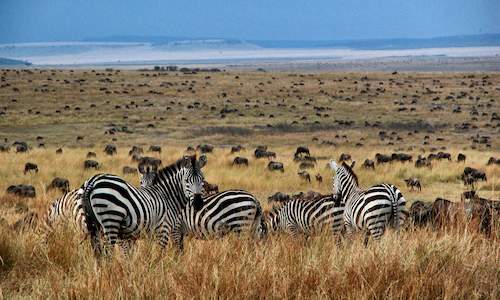
Every year, approximately 1.3 million wildebeest plus hundreds of thousands of other animals including gazelles and zebras move from Tanzania in the south travelling north into Kenya in search of green pastures. This is the well documented great migration. There is also a lesser known Loita wildebeest migration, that also occurs annually.
The Little Migration - Loita Hills Migration
Just north of the Masai Mara are the Loita plains and nearby Loita Hills. These savannah and pastoral grazing grounds, in the southern Great Rift Valley, are an important grazing area for the resident Kenyan wildebeest, gazelles and zebras during the wet seasons. However, during dry seasons they start to move south into the Masai Mara.In May when the grass has all dried up about 250,000 resident wildebeest and zebra start to go on the move in search of food from Loita Hills to the north east of the Masai Mara.
In July, they meet up with another larger migratory contingent coming from the south, the great migration. The Mara Plains become a crowded mass of frolicking wildebeest, all competing for the lush grass.
In October, when the grass has been diminished the larger migration starts to head south again, towards the rains in the Serengeti. The Loita Hill residents tend to stay in the Masai Mara area, only heading back to the Loita plains again when the rains start there in March.
The Masai Mara area has great game viewing all year round; the frenzied river crossings of the Mara River in July and October are a sight to behold; as the millions of wildebeest attempt to cross over the border in their pursuit of fresh grass. The Loita Hills migration do not cross any rivers, but the sight of thousands of wildebeest and of course the predators preying on them, is also a sight worth seeing.
Visiting the Masai Mara in May/June is one of the best times of the year to go on safari here. The grass is green following the long rains, it’s ‘out of season’, so the rates are lower and better still it is less crowded and the game is there en masse.
Human Animal Conflict
Over the past few years, settlements have developed in and around the Loita region, the farmers have erected fences and agriculture in the form of wheat growing commenced. This is causing parts of the Loita Plains to be cut off from the resident wildebeest and other plains game. Resulting in the resident wildebeest and other game are arriving earlier and staying longer in the Masai Mara area.This is also having an impact on the migrating herds from the Serengeti, as it is putting increased pressure on the grasslands of the Masai Mara, making the grazing diminish earlier.
In years of good rains, there is less of a problem; but in the years of bad rains, the situation may become more dire.

 The Great Wildebeest Migration of East Africa is an amazing natural cycle and Masai Mara National Reserve in Kenya is at the forefront of th...
The Great Wildebeest Migration of East Africa is an amazing natural cycle and Masai Mara National Reserve in Kenya is at the forefront of th...